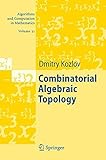Combinatorial Algebraic Topology [electronic resource]/ by Dmitry Kozlov.
Series: Algorithms and Computation in Mathematics ; 21Publication details: Berlin, Heidelberg: Springer Berlin Heidelberg, 2008.Description: digitalISBN:- 9783540719625
- 514.2
Overture -- Part I Concepts of Algebraic Topology -- 2 Cell complexes -- 3 Homology groups -- 4 Concepts of Category Theory -- 5 Exact sequences -- 6 Homotopy -- 7 Cofibrations -- 8 Principle -bundles and Stiefel-Whitney characteristic classes -- Part II Methods of Combinatorial Algebraic Topology -- 9 Combinatorial complexes melange -- 10 Acyclic categories -- 11 Discrete Morse theory -- 12 Lexicographic shellability -- 13 Evasiveness and closure operators -- 14 Colimits and quotients -- 15 Homotopy colimits -- Part III Complexes of Graph Homomorphisms -- 17 Chromatic numbers and the Kneser conjecture -- 18 Structural theory of morphism complexes -- 19 Characteristic classes and chromatic numbers -- 20 Applications of spectral sequences to Hom-complexes -- References -- Index .
Combinatorial algebraic topology is a fascinating and dynamic field at the crossroads of algebraic topology and discrete mathematics. This volume is the first comprehensive treatment of the subject in book form. The first part of the book constitutes a swift walk through the main tools of algebraic topology, including Stiefel-Whitney characteristic classes, which are needed for the later parts. Readers - graduate students and working mathematicians alike - will probably find particularly useful the second part, which contains an in-depth discussion of the major research techniques of combinatorial algebraic topology. Our presentation of standard topics is quite different from that of existing texts. In addition, several new themes, such as spectral sequences, are included. Although applications are sprinkled throughout the second part, they are principal focus of the third part, which is entirely devoted to developing the topological structure theory for graph homomorphisms. The main benefit for the reader will be the prospect of fairly quickly getting to the forefront of modern research in this active field .


There are no comments on this title.